歓待のための最後の晩餐
Last Supper, Ultima Cena
歓待のための最後の晩餐
Last Supper, Ultima Cena
In ipsa nocte in qua tradebatur, ad Ultimam Cenam congregavit Iesus discipulos suos, ut prophetiae implerentur, ecclesia fundaretur, atque sacerdotium promulgaretur. In hac novissima cena, congregavit discipulos in coenaculo ut coelebraretur Pascha Iudaica. Victima huius coenae sacrificalis, tamen, non fuit agnus qui sacrificatur in memoria exodi, sed Iesus Christus ipse, qui se obtulit die sequente super crucem. A catholicis consideratur tamquam prima Missa. Ultima Cena in evangelio Matthaei sic narratur:
Vespere autem facto, discumbebat cum
Duodecim. Et edentibus illis, dixit: "Amen dico vobis: Unus vestrum me
traditurus est." Et contristati valde, coeperunt singuli dicere ei:
"Numquid ego sum, Domine?" At ipse respondens ait: "Qui intingit mecum
manum in paropside, hic me tradet. Filius quidem hominis vadit, sicut
scriptum est de illo; vae autem homini illi, per quem Filius hominis
traditur! Bonum erat ei, si natus non fuisset homo ille." Respondens
autem Iudas Iscariot, qui tradidit eum, dixit: "Numquid ego sum,
Rabbi?" Ait illi: "Tu dixisti."
Cenantibus autem eis, accepit Iesus panem et benedixit ac fregit deditque discipulis et ait: "Accipite, comedite: hoc est corpus meum." Et accipiens calicem, gratias egit et dedit illis dicens: "Bibite ex hoc omnes: hic est enim sanguis meus novi testamenti, qui pro multis effunditur in remissionem peccatorum. Dico autem vobis: Non bibam amodo de hoc genimine vitis usque in diem illum, cum illud bibam vobiscum novum in regno Patris mei." Et hymno dicto, exierunt in montem Oliveti. [Mateo 26:20-30]
https://la.wikipedia.org/wiki/Ultima_Cena
Sequentia hispanice scripta est.
20 Cuando llegó la
noche, se sentó a la mesa con los doce. 21 Y mientras comían, dijo: De
cierto os digo, que uno de vosotros me va a entregar. 22 Y
entristecidos en gran manera, comenzó cada uno de ellos a decirle: ¿Soy
yo, Señor? 23 Entonces él respondiendo, dijo: El que mete la mano
conmigo en el plato, ese me va a entregar. 24 A la verdad el Hijo del
Hombre va, según está escrito de él, mas ¡ay de aquel hombre por quien
el Hijo del Hombre es entregado! Bueno le fuera a ese hombre no haber
nacido. 25 Entonces respondiendo Judas, el que le entregaba, dijo: ¿Soy
yo, Maestro? Le dijo: Tú lo has dicho. [Mateo
26:20-25]
26 Y mientras comían, tomó Jesús el pan, y bendijo, y lo partió, y dio
a sus discípulos, y dijo: Tomad, comed; esto es mi cuerpo. 27 Y tomando
la copa, y habiendo dado gracias, les dio, diciendo: Bebed de ella
todos; 28 porque esto es mi sangre del nuevo pacto, que por muchos es
derramada para remisión de los pecados. 29 Y os digo que desde ahora no
beberé más de este fruto de la vid, hasta aquel día en que lo beba
nuevo con vosotros en el reino de mi Padre. 30 Y cuando hubieron
cantado el himno, salieron al monte de los Olivos.
[Mateo 26:26-30]
★最後の晩餐
キリスト教美術における最後の晩餐の描写は、何世紀にもわたって芸術の巨匠た ちによって描かれてきた。レオナルド・ダ・ヴィンチが1490年代後半にイタリアのミラノに描いた壁画が最もよく知られた例である。// The First Supper 1988 acrylic on panel, 120 x 240 cm by Susan Dorothea White.
★名前のリスト
From left to right the Apostles are
Bartholomew, James the son of Alphaeus, Andrew, Judas, Peter, John, in
the middle is Jesus, then Thomas, James the Greater, Philip, Matthew,
Jude Thaddeus, Simon. The Apostles are grouped in threes and each has
something significant happening in the distinction of his personality.
| The Last Supper is the
final meal that, in the Gospel accounts, Jesus shared with his apostles
in Jerusalem before his crucifixion.[2] The Last Supper is commemorated
by Christians especially on Holy Thursday.[3] The Last Supper provides
the scriptural basis for the Eucharist, also known as "Holy Communion"
or "The Lord's Supper".[4] The First Epistle to the Corinthians contains the earliest known mention of the Last Supper. The four canonical gospels state that the Last Supper took place in the week of Passover, days after Jesus's triumphal entry into Jerusalem, and before Jesus was crucified on Good Friday.[5][6] During the meal, Jesus predicts his betrayal by one of the apostles present, and foretells that before the next morning, Peter will thrice deny knowing him.[5][6] The three Synoptic Gospels and the First Epistle to the Corinthians include the account of the institution of the Eucharist in which Jesus takes bread, breaks it and gives it to those present, saying "This is my body given to you".[5][6] The Gospel of John tells of Jesus washing the feet of the apostles,[7] giving the new commandment "to love one another as I have loved you",[8] and has a detailed farewell discourse by Jesus, calling the apostles who follow his teachings "friends and not servants", as he prepares them for his departure.[9][10][11] Some scholars have looked to the Last Supper as the source of early Christian Eucharistic traditions.[12][13][14][15][16][17] Others see the account of the Last Supper as derived from 1st-century eucharistic practice as described by Paul in the mid-50s.[13][18][19][20] |
最後の晩餐は、福音書の記述では、イエスが十字架にかけられる前にエル
サレムで使徒たちと分かち合った最後の食事である。最後の晩餐は、特に聖木曜日にキリスト教徒によって記念される。最後の晩餐は、"聖餐 "または
"主の晩餐 "とも呼ばれる聖体の聖典的根拠となる。 『コリントの信徒への手紙一』には、最後の晩餐に関する最古の記述がある。四つの正典福音書によれば、最後の晩餐は過越の祭りの週に行われ、イエスがエル サレムに凱旋した数日後、聖金曜日にイエスが十字架につけられる前に行われた。食事中、イエスはその場にいた使徒の一人に裏切られることを予言し、翌朝ま でにペテロが三度イエスを知らないと否定することを予告した。 3つの共観福音書とコリントの信徒への第一の手紙には、イエスがパンを取り、それを裂き、「これはあなたがたに与えられるわたしの体である」と言ってその 場にいる人々に与える聖体授与の記述がある。ヨハネによる福音書では、イエスが使徒たちの足を洗い、「わたしがあなたがたを愛したように、互いに愛し合い なさい」という新しい戒めを与え、イエスの教えに従う使徒たちを「しもべではなく友」と呼び、イエスの旅立ちに備えるイエスの別れの講話が詳しく書かれて いる。 初期キリスト教の聖体の伝統の源流として、最後の晩餐に注目する学者もいる。また、最後の晩餐の記述は、50年代半ばにパウロによって記述された1世紀の 聖体礼儀の習慣に由来すると考える学者もいる。 |
Terminology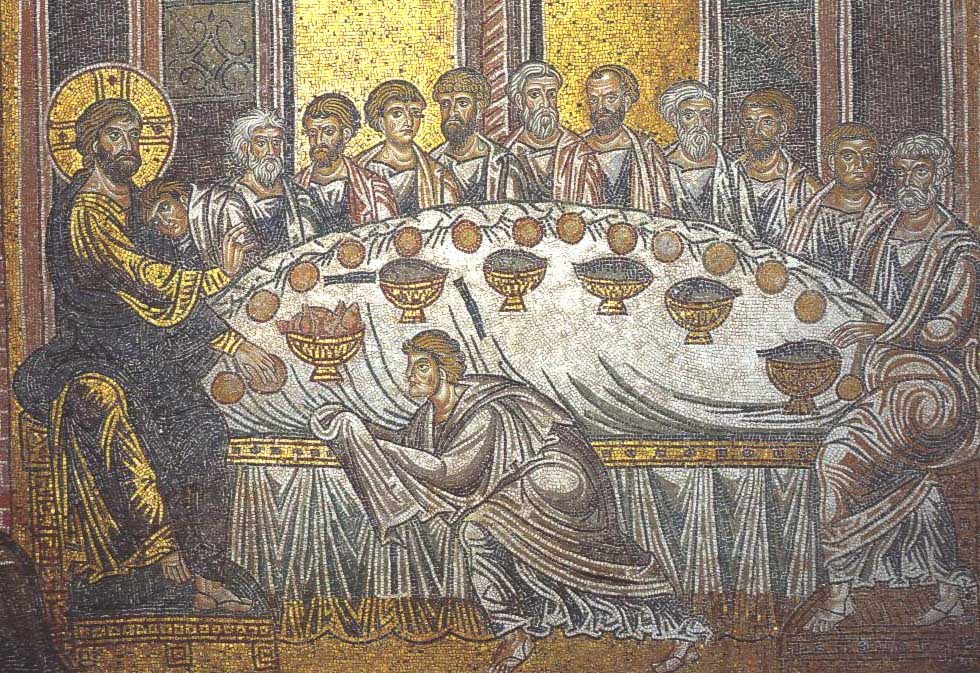 Last Supper, Monreale Cathedral mosaics (Palermo, Sicily, Italy) The term "Last Supper" does not appear in the New Testament,[21][22] but traditionally many Christians refer to such an event.[22] The term "Lord's Supper" refers both to the biblical event and the act of "Holy Communion" and Eucharistic ("thanksgiving") celebration within their liturgy. Evangelical Protestants also use the term "Lord's Supper", but most do not use the terms "Eucharist" or the word "Holy" with the name "Communion".[23] The Eastern Orthodox use the term "Mystical Supper" which refers both to the biblical event and the act of Eucharistic celebration within liturgy.[24] The Russian Orthodox also use the term "Secret Supper" (Church Slavonic: "Тайная вечеря", Taynaya vecherya). |
用語解説 最後の晩餐、モンレアーレ大聖堂のモザイク(イタリア、シチリア島、パレルモ) 最後の晩餐」という用語は新約聖書には登場しないが[21][22]、伝統的に多くのキリスト教徒がそのような出来事を指している[22]。福音派のプロ テスタントも「主の晩餐」という用語を使用するが、ほとんどのプロテスタントは「聖体」という用語や「聖体」という単語を「聖餐式」という名称と共に使用 しない[23]。 東方正教会は「神秘の晩餐」という用語を使用するが、これは聖書の出来事と典礼の中での聖体祭儀の行為の両方を指す。ロシア正教徒は「秘密の晩餐」(教会 スラヴ語: Тайная вечеря, Taynaya vecherya)という用語も用いる。 |
| Scriptural basis The last meal that Jesus shared with his apostles is described in all four canonical Gospels[25] as having taken place in the week of the Passover. This meal later became known as the Last Supper.[6] The Last Supper was likely a retelling of the events of the last meal of Jesus among the early Christian community, and became a ritual which recounted that meal.[26] Paul's First Epistle to the Corinthians,[27] which was likely written before the Gospels, includes a reference to the Last Supper but emphasizes the theological basis rather than giving a detailed description of the event or its background.[5][6] Background and setting 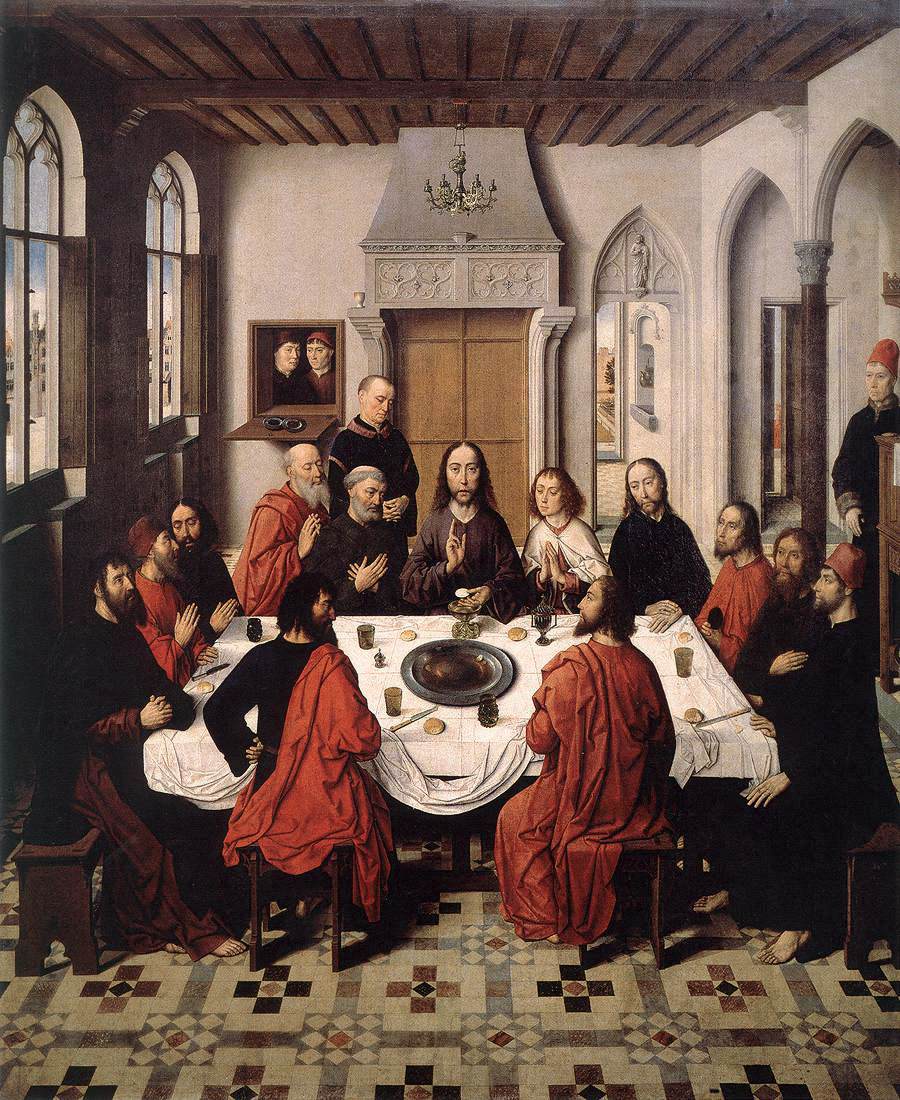 The Last Supper by Dieric Bouts The overall narrative that is shared in all Gospel accounts that leads to the Last Supper is that after the triumphal entry into Jerusalem early in the week, and encounters with various people and the Jewish elders, Jesus and his disciples share a meal towards the end of the week. After the meal, Jesus is betrayed, arrested, tried, and then crucified.[5][6] Key events in the meal are the preparation of the disciples for the departure of Jesus, the predictions about the impending betrayal of Jesus, and the foretelling of the upcoming denial of Jesus by Apostle Peter.[5][6] Prediction of Judas' betrayal Main article: Jesus predicts his betrayal In Matthew 26:24–25, Mark 14:18–21, Luke 22:21–23 and John 13:21–30, during the meal, Jesus predicted that one of the apostles present would betray him.[28][29] Jesus is described as reiterating, despite each apostle's assertion that he would not betray Jesus, that the betrayer would be one of those who were present, and saying that there would be "woe to the man who betrays the Son of man! It would be better for him if he had not been born."[30] In Matthew 26:23–25 and John 13:26–27, Judas is specifically identified as the traitor.[31] In the Gospel of John, when asked about the traitor, Jesus states: "It is the one to whom I will give this piece of bread when I have dipped it in the dish." Then, dipping the piece of bread, he gave it to Judas, the son of Simon Iscariot. As soon as Judas took the bread, Satan entered into him. — Evans 2003, pp. 465–477 Fahlbusch 2005, pp. 52–56 |
聖書の根拠 イエスが使徒たちと分かち合った最後の食事は、4つの福音書[25]すべてに過越の祭りの週に行われたと記述されている。この食事は後に最後の晩餐として 知られるようになった[6]。最後の晩餐は、おそらく初期キリスト教共同体の間でイエスの最後の食事の出来事が語られ、その食事を再現する儀式となった [26]。 福音書よりも前に書かれたと思われるパウロの『コリントの信徒への手紙一』[27]には、最後の晩餐についての言及があるが、その出来事や背景についての 詳細な記述はなく、神学的な根拠が強調されている[5][6]。 背景と設定  ディエリック・ブーツ作『最後の晩餐』 すべての福音書に共通する最後の晩餐に至る全体的な物語は、週の初めにエルサレムに凱旋し、様々な人々やユダヤ人の長老たちと出会った後、週の終わりにイ エスと弟子たちが食事を共にするというものである。食事の後、イエスは裏切られ、逮捕され、裁判にかけられ、そして十字架にかけられる[5][6]。 食事の中で重要な出来事は、イエスの旅立ちに対する弟子たちの準備、差し迫ったイエスの裏切りについての予言、使徒ペテロによる来るべきイエスの否定の予 言である[5][6]。 ユダの裏切りの予言 主な記事 イエスの裏切り予言 マタイによる福音書26:24-25、マルコによる福音書14:18-21、ルカによる福音書22:21-23、ヨハネによる福音書13:21-30にお いて、イエスは食事の間に、その場にいた使徒の一人がイエスを裏切ることを予言した。 28][29] イエスは、自分はイエスを裏切らないと各使徒が主張しているにもかかわらず、裏切る者はその場にいた者の一人であると繰り返し、「人の子を裏切る者には災 いがある!人の子を裏切る者に災いあれ。生まれて来なかった方が、その人のためである」[30]。 マタイによる福音書26:23-25とヨハネによる福音書13:26-27では、ユダは裏切り者として具体的に特定されている[31]。 ヨハネによる福音書では、裏切り者について尋ねられたとき、イエスはこう述べている: 「それは、わたしがこのパンを皿に浸したとき、わたしがこのパンを与える者である」。そして、パンを浸して、イスカリオテのシモンの子ユダに渡した。ユダ がパンを受け取るとすぐに、サタンがユダの中に入り込んだ。 - エヴァンス 2003, 465-477 頁 ファールブッシュ 2005, 52-56 頁 |
| Institution of the Eucharist The three Synoptic Gospel accounts describe the Last Supper as a Passover meal,[32][33] disagreeing with John.[33] Each gives somewhat different versions of the order of the meal. In chapter 26 of the Gospel of Matthew, Jesus prays thanks for the bread, divides it, and hands the pieces of bread to his disciples, saying "Take, eat, this is my body." Later in the meal Jesus takes a cup of wine, offers another prayer, and gives it to those present, saying "Drink from it, all of you; for this is my blood of the covenant, which is poured out for many for the forgiveness of sins. I tell you, I will never again drink of this fruit of the vine until that day when I drink it new with you in my Father's kingdom." In chapter 22 of the Gospel of Luke, however, the wine is blessed and distributed before the bread, followed by the bread, then by a second, larger cup of wine, as well as somewhat different wordings. Additionally, according to Paul and Luke, he tells the disciples "do this in remembrance of me." This event has been regarded by Christians of most denominations as the institution of the Eucharist. There is recorded celebration of the Eucharist by the early Christian community in Jerusalem.[10] The institution of the Eucharist is recorded in the three Synoptic Gospels and in Paul's First Epistle to the Corinthians. As noted above, Jesus's words differ slightly in each account. In addition, Luke 22:19b–20 is a disputed text which does not appear in some of the early manuscripts of Luke.[34] Some scholars, therefore, believe that it is an interpolation, while others have argued that it is original.[35][36] A comparison of the accounts given in the Gospels and 1 Corinthians is shown in the table below, with text from the ASV. The disputed text from Luke 22:19b–20 is in italics. |
聖体の授与 共観福音書の3つの記述は、最後の晩餐を過越の食事として記述しており[32][33]、ヨハネとは異なっている[33]。マタイによる福音書の第26章 では、イエスはパンに感謝して祈り、パンを分け、弟子たちにパンのかけらを手渡し、"取りなさい、食べなさい、これはわたしのからだである "と言う。食事の後、イエスはぶどう酒の杯を取り、もう一度祈りをささげ、その場にいる人々に渡して言われた。あなたがたに言っておくが、私の父の王国 で、あなたがたとともにこのぶどうの実を新たに飲むその日まで、私は二度とこのぶどうの実を飲むことはない。" しかし、ルカによる福音書22章では、パンの前にぶどう酒が祝福され、配られ、パンの後に2杯目の大きなぶどう酒が配られ、言葉も多少異なっている。さら に、パウロとルカによれば、弟子たちに "わたしを思い起こしてこれを行いなさい "と告げている。この出来事は、ほとんどの宗派のキリスト教徒によって、聖体の制定とみなされてきた。エルサレムの初期キリスト教共同体が聖体を祝ったと いう記録もある[10]。 聖体の授与は、3つの共観福音書とパウロのコリント人への第一の手紙に記録されている。上述のように、イエスの言葉はそれぞれの記述でわずかに異なってい る。加えて、ルカによる福音書22:19b-20は、ルカによる福音書の初期の写本のいくつかには出てこない、論争の的になっているテキストである [34]。それゆえ、ある学者はこのテキストは補筆であると信じているが、他の学者はオリジナルであると主張している[35][36]。 福音書とコリントの信徒への手紙一の記述の比較は、ASVのテキストとともに以下の表に示されている。ルカによる福音書22:19b-20の論争中のテキ ストは斜体で示されている。 |
| Mark 14:22–24 And as they were eating, he took bread, and when he had blessed, he brake it, and gave to them, and said, Take ye: this is my body. And he took a cup, and when he had given thanks, he gave to them: and they all drank of it. And he said unto them, 'This is my blood of the covenant, which is poured out for many.'[37] |
マルコ14:22-24 そして, 彼らが食べているとき, パンを取り, 祝福してから, それを裂き, 彼らに与えて言われた, 「取りなさい, これはわたしのからだである」. そして杯を取り、感謝をささげてから彼らに与えた。そして彼らに言われた,『これは多くの人のために注がれるわたしの契約の血である』」[37]。 |
| Matthew 26:26–28 And as they were eating, Jesus took bread, and blessed, and brake it; and he gave to the disciples, and said, 'Take, eat; this is my body.' And he took a cup, and gave thanks, and gave to them, saying, 'Drink ye all of it; for this is my blood of the covenant, which is poured out for many unto remission of sins.'[38] |
マタイ26:26-28 彼らが食事をしていると、イエスはパンを取り、祝福して裂かれた。 また,杯を取って感謝し,彼らに与えて言われた,『これをみな飲みなさい。これは,罪の赦しのために多くの人のために注がれるわたしの契約の血である』」 [38]。 |
| 1 Corinthians
11:23–25 For I received of the Lord that which also I delivered unto you, that the Lord Jesus in the night in which he was betrayed took bread; and when he had given thanks, he brake it, and said, 'This is my body, which is for you: this do in remembrance of me.'[39] In like manner also the cup, after supper, saying, 'This cup is the new covenant in my blood: this do, as often as ye drink it, in remembrance of me.' |
第一コリント11:23-25
主イエスが裏切られた夜,パンを取り,感謝をささげてから,それを裂き,『これは,あなたがたのためにあるわたしのからだである。 この杯は、わたしの血による新しい契約であり、あなたがたが飲むたびに、わたしを思い起こしてこれを行いなさい』。 |
| Luke 22:19–20 And he took bread, and when he had given thanks, he brake it, and gave to them, saying, 'This is my body which is given for you: this do in remembrance of me.'[40] And the cup in like manner after supper, saying, 'This cup is the new covenant in my blood, even that which is poured out for you.' |
ルカ 22:19-20 そして、パンを取り、感謝をささげてから、それを裂き、彼らに与えて言われた、『これは、あなたがたのために与えられるわたしのからだである。 晩餐の後、同じようにこう言った、「この杯は、わたしの血による新しい契約であり、あなたがたのために注がれるものである」。 |
| Jesus' actions in sharing the
bread and wine have been linked with Isaiah 53:12[41] which refers to a
blood sacrifice that, as recounted in Exodus 24:8,[42] Moses offered in
order to seal a covenant with God. Some scholars interpret the
description of Jesus' action as asking his disciples to consider
themselves part of a sacrifice, where Jesus is the one due to
physically undergo it.[43] Although the Gospel of John does not include a description of the bread and wine ritual during the Last Supper, most scholars agree that John 6:58–59[44] (the Bread of Life Discourse) has a Eucharistic nature and resonates with the "words of institution" used in the Synoptic Gospels and the Pauline writings on the Last Supper.[45] |
パンとぶどう酒を分かち合うイエスの行為は、出エジプト記24:8
[42]に記されているように、モーセが神との契約を結ぶために捧げた血のいけにえに言及しているイザヤ書53:12[41]と関連している。一部の学者
は、イエスの行動の描写を、弟子たちに、イエスが肉体的にそれを受けることになる生け贄の一部であると考えるように求めていると解釈している[43]。 ヨハネによる福音書には最後の晩餐におけるパンとぶどう酒の儀式に関する記述はないが、ほとんどの学者はヨハネによる福音書6:58-59[44](「い のちのパン」講話)が聖体的な性格を持ち、共観福音書や最後の晩餐に関するパウロの著作で用いられている「儀式の言葉」と共鳴していることに同意している [45]。 |
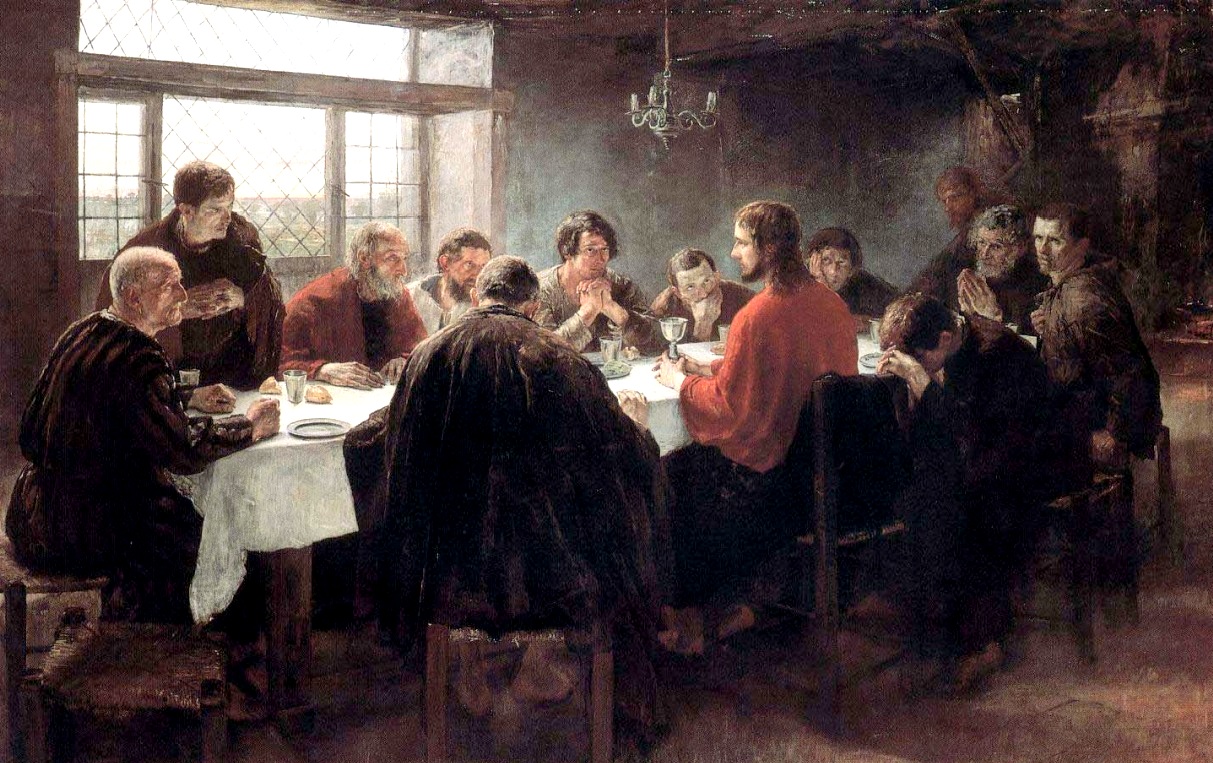 The Last Supper by Fritz von Uhde (1886) |
|
| Prediction of Peter's denial Main article: Denial of Peter In Matthew 26:33–35, Mark 14:29–31, Luke 22:33–34 and John 13:36–8, Jesus predicts that Peter will deny knowledge of him, stating that Peter will disown him three times before the rooster crows the next morning.[46] The three Synoptic Gospels mention that after the arrest of Jesus, Peter denied knowing him three times, but after the third denial, heard the rooster crow and recalled the prediction as Jesus turned to look at him. Peter then began to cry bitterly.[47][48] Elements unique to the Gospel of John See also: Washing the feet of the Apostles, The New Commandment, and Farewell discourse  Jesus giving the Farewell Discourse to his eleven remaining disciples, from the Maesta by Duccio, 1308–1311 John 13 includes the account of the washing the feet of the Apostles by Jesus before the meal.[49] In this episode, Apostle Peter objects and does not want to allow Jesus to wash his feet, but Jesus answers him, "Unless I wash you, you have no part with me",[50] after which Peter agrees. In the Gospel of John, after the departure of Judas from the Last Supper, Jesus tells his remaining disciples [51] that he will be with them for only a short time, then gives them a New Commandment, stating:[52][53] "A new command I give you: Love one another. As I have loved you, so you must love one another. By this everyone will know that you are my disciples if you love one another."[54] Two similar statements also appear later in John 15:12: "My command is this: Love each other as I have loved you",[55] and John 15:17: "This is my command: Love each other."[56][53] At the Last Supper in the Gospel of John, Jesus gives an extended sermon to his disciples.[57] This discourse resembles farewell speeches called testaments, in which a father or religious leader, often on the deathbed, leaves instructions for his children or followers.[58] This sermon is referred to as the Farewell discourse of Jesus, and has historically been considered a source of Christian doctrine, particularly on the subject of Christology. John 17:1–26 is generally known as the Farewell Prayer or the High Priestly Prayer, given that it is an intercession for the coming Church.[59] The prayer begins with Jesus's petition for his glorification by the Father, given that completion of his work and continues to an intercession for the success of the works of his disciples and the community of his followers.[59] |
ペテロの否定の予言 主な記事 ペテロの否定 マタイによる福音書26:33-35、マルコによる福音書14:29-31、ルカによる福音書22:33-34、ヨハネによる福音書13:36-8におい て、イエスはペテロがイエスを知っていることを否定することを予言し、ペテロは翌朝のにわとりが鳴く前に3回イエスを見捨てるだろうと述べている [46]。 3つの共観福音書によると、イエスの逮捕後、ペテロはイエスを知っていることを3回否定したが、3回目の否定の後、にわとりが鳴くのを聞き、イエスが彼を 見ようと振り向くと予言を思い出した。その後、ペテロは激しく泣き始めた[47][48]。 ヨハネによる福音書特有の要素 以下も参照: 使徒たちの足を洗う、新しい戒め、別れの講話  11人の弟子たちに別れの言葉を述べるイエス(ドゥッチョ作『マエスタ』より、1308-1311年) ヨハネによる福音書13章には、食事の前にイエスが使徒たちの足を洗ったことが書かれている[49]。このエピソードでは、使徒ペトロがイエスに足を洗わ せたくないと反対するが、イエスは「わたしがあなたがたを洗わなければ、あなたがたはわたしといっしょにいることはできない」と答え[50]、ペトロは同 意する。 ヨハネによる福音書では、最後の晩餐からユダが去った後、イエスは残された弟子たちに[51]、自分が彼らと一緒にいるのはほんの少しの間だけだと告げ、 それから次のように新しい戒めを与える[52][53]: 互いに愛し合いなさい。わたしがあなたがたを愛したように、あなたがたも互いに愛し合いなさい。わたしがあなたがたを愛したように、あなたがたも互いに愛 し合わなければならない」[54]: わたしがあなたがたを愛したように、互いに愛し合いなさい: 互いに愛し合いなさい」[56][53]。 ヨハネによる福音書の最後の晩餐で、イエスは弟子たちに長い説教をする[57]。この説教は、遺言と呼ばれる別れの演説に似ており、父親や宗教的指導者 が、しばしば臨終の床で、自分の子供や信者たちに指示を残すものである[58]。 この説教はイエスの告別説教と呼ばれ、歴史的にキリスト教の教義、特にキリスト論の主題の源とみなされてきた。ヨハネによる福音書17:1-26は、来る べき教会のための執り成しであることから、一般に「別れの祈り」または「大祭司の祈り」として知られている[59]。この祈りは、イエスの御業が完成した ことから、御父によって栄光を与えられるようにというイエスの願いから始まり、弟子たちの業と信者たちの共同体の成功のための執り成しへと続く[59]。 |
| Time and place Date 13th century Orthodox Russian icon from 1497 See also: Chronology of Jesus Historians estimate that the date of the crucifixion fell in the range AD 30–36.[60][61][62] Isaac Newton and Colin Humphreys have ruled out the years 31, 32, 35, and 36 on astronomical grounds, leaving 7 April AD 30 and 3 April AD 33 as possible crucifixion dates.[63] Humphreys 2011, pp. 72, 189 proposes narrowing down the date of the Last Supper as having occurred in the evening of Wednesday, 1 April AD 33, by revising Annie Jaubert's double-Passover theory. Historically, various attempts to reconcile the three synoptic accounts with John have been made, some of which are indicated in the Last Supper by Francis Mershman in the 1912 Catholic Encyclopedia.[64] The Maundy Thursday church tradition assumes that the Last Supper was held on the evening before the crucifixion day (although, strictly speaking, in no Gospel is it unequivocally said that this meal took place on the night before Jesus died).[65] A new approach to resolve this contrast was undertaken in the wake of the excavations at Qumran in the 1950s when Annie Jaubert argued that there were two Passover feast dates: while the official Jewish lunar calendar had Passover begin on a Friday evening in the year that Jesus died, a solar calendar was also used, for instance by the Essene community at Qumran, which always had the Passover feast begin on a Tuesday evening. According to Jaubert, Jesus would have celebrated the Passover on Tuesday, and the Jewish authorities three days later, on Friday.[66] Humphreys has disagreed with Jaubert's proposal on the grounds that the Qumran solar Passover would always fall after the official Jewish lunar Passover. He agrees with the approach of two Passover dates, and argues that the Last Supper took place on the evening of Wednesday 1 April 33, based on his recent discovery of the Essene, Samaritan, and Zealot lunar calendar, which is based on Egyptian reckoning.[67][68] In a review of Humphreys' book, the Bible scholar William R Telford points out that the non-astronomical parts of his argument are based on the assumption that the chronologies described in the New Testament are historical and based on eyewitness testimony. In doing so, Telford says, Humphreys has built an argument upon unsound premises which "does violence to the nature of the biblical texts, whose mixture of fact and fiction, tradition and redaction, history and myth all make the rigid application of the scientific tool of astronomy to their putative data a misconstrued enterprise."[69] Location Main article: Cenacle 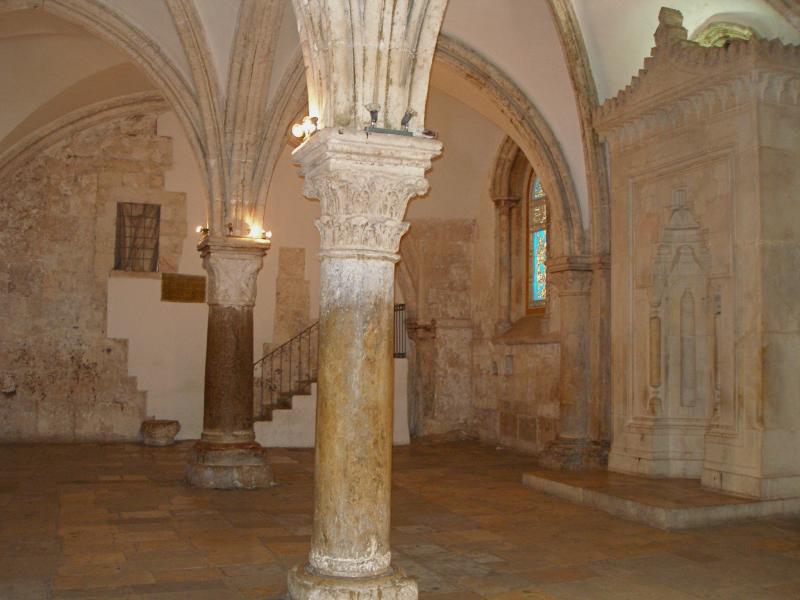 The Cenacle on Mount Zion, claimed to be the location of the Last Supper and Pentecost. According to later tradition, the Last Supper took place in what is today called The Room of the Last Supper on Mount Zion, just outside the walls of the Old City of Jerusalem, and is traditionally known as The Upper Room. This is based on the account in the Synoptic Gospels that states that Jesus had instructed two disciples (Luke 22:8 specifies that Jesus sent Peter and John) to go to "the city" to meet "a man carrying a jar of water", who would lead them to a house, where they would find "a large upper room furnished and ready".[70] In this upper room they "prepare the Passover". No more specific indication of the location is given in the New Testament, and the "city" referred to may be a suburb of Jerusalem, such as Bethany, rather than Jerusalem itself. A structure on Mount Zion in Jerusalem is currently called the Cenacle and is purported to be the location of the Last Supper. Bargil Pixner claims the original site is located beneath the current structure of the Cenacle on Mount Zion.[71] The traditional location is in an area that, according to archaeology, had a large Essene community, a point made by scholars who suspect a link between Jesus and the group.[72] Saint Mark's Syrian Orthodox Church in Jerusalem is another possible site for the room in which the Last Supper was held, and contains a Christian stone inscription testifying to early reverence for that spot. Certainly the room they have is older than that of the current cenaculum (crusader – 12th century) and as the room is now underground the relative altitude is correct (the streets of 1st century Jerusalem were at least twelve feet (3.7 metres) lower than those of today, so any true building of that time would have even its upper story currently under the earth). They also have a revered Icon of the Virgin Mary, reputedly painted from life by St Luke. |
時間と場所 日付 1497年に制作された13世紀のロシア正教会のイコン こちらもご覧ください: イエスの年表 アイザック・ニュートンとコリン・ハンフリーズは、天文学的根拠から31年、32年、35年、36年を除外し、30年4月7日と33年4月3日を磔刑の可 能性のある日付として残している[63]。 [63] Humphreys 2011, pp. 72, 189は、アニー・ジョベールの二重過越説を修正することによって、最後の晩餐の日付が紀元33年4月1日(水)の夕方に起こったと絞り込むことを提案し ている。 歴史的には、3つの共観的記述とヨハネによる記述を調和させる様々な試みがなされており、そのいくつかは1912年の『カトリック百科事典』のフランシ ス・マーシュマンによる「最後の晩餐」に示されている[64]。 モーニ木曜日の教会の伝統は、最後の晩餐が十字架刑の日の前夜に行われたと仮定している(ただし、厳密に言えば、どの福音書においても、この食事がイエス が亡くなる前夜に行われたとは明確に述べられていない)[65]。 この対比を解決するための新たなアプローチは、1950年代のクムランでの発掘をきっかけに、アニー・ヤウベルトが過越祭の日付が2つあると主張したとき に行われた。ジャウベールによれば、イエスは火曜日に過越祭を祝い、ユダヤ当局はその3日後の金曜日に過越祭を祝ったという[66]。ハムフリズ氏は、ク ムランの太陽暦の過越祭は常にユダヤの公式な太陰暦の過越祭の後に行われるという理由で、ジャウベールの提案に反対している。彼は2つの過越の日というア プローチに同意し、エジプト暦に基づくエッセネ派、サマリア人、熱心党の太陰暦の最近の発見に基づいて、最後の晩餐は33年4月1日(水)の夕方に行われ たと主張している[67][68]。 聖書学者のウィリアム・R・テルフォード(William R Telford)は、ハムフリズの著書の書評の中で、彼の主張の天文以外の部分は、新約聖書に記述されている年表が歴史的なものであり、目撃証言に基づい ているという仮定に基づいていると指摘している。事実と虚構、伝統と再編集、歴史と神話が混在している聖書のテキストの本質を冒涜するものであり、天文学 という科学的道具を、その仮定されたデータに厳密に適用することは、誤った解釈である」[69]。 場所 主な記事 セナクル  最後の晩餐と聖霊降臨の場所とされるシオン山の慰安所。 後世の伝承によれば、最後の晩餐は、エルサレム旧市街の城壁のすぐ外側にある、今日「シオン山の最後の晩餐の間」と呼ばれている場所で行われ、伝統的に 「上の部屋」として知られている。これは、イエスが二人の弟子(ルカ22:8は、イエスがペテロとヨハネを遣わしたことを明記している)に「水の入った壷 を持った人」に会うために「町」に行くように指示し、その人が彼らをある家に案内し、そこで「家具が備え付けられ、準備が整っている大きな上の部屋」を見 つけたという共観福音書の記述に基づいている[70]。 新約聖書にはこれ以上具体的な場所の記述はなく、言及されている「町」とは、エルサレムそのものではなく、ベタニヤのようなエルサレム郊外のことかもしれ ない。 現在、エルサレムのシオン山にある建造物は「セナクル」と呼ばれ、最後の晩餐が行われた場所とされている。バーギル・ピクスナーは、オリジナルの場所はシ オン山にある現在の慰安所の建造物の下にあると主張している[71]。 伝統的な場所は、考古学によれば、大規模なエッセネ派のコミュニティがあった地域にあり、イエスとこのグループとの関連を疑う学者たちによって指摘されて いる[72]。 エルサレムの聖マルコ・シリア正教会は、最後の晩餐が行われた部屋のもう一つの可能性のある場所であり、その場所に対する初期の畏敬の念を証言するキリス ト教の石碑がある。確かに、彼らが持っている部屋は、現在のセナクルム(十字軍-12世紀)よりも古く、その部屋は現在地下にあるため、相対的な高度は正 しい(1世紀のエルサレムの街路は、現在の街路よりも少なくとも12フィート(3.7メートル)低かった。) また、聖ルカが実物から描いたとされる聖母マリアのイコンもある。 |
Theology of the Last Supper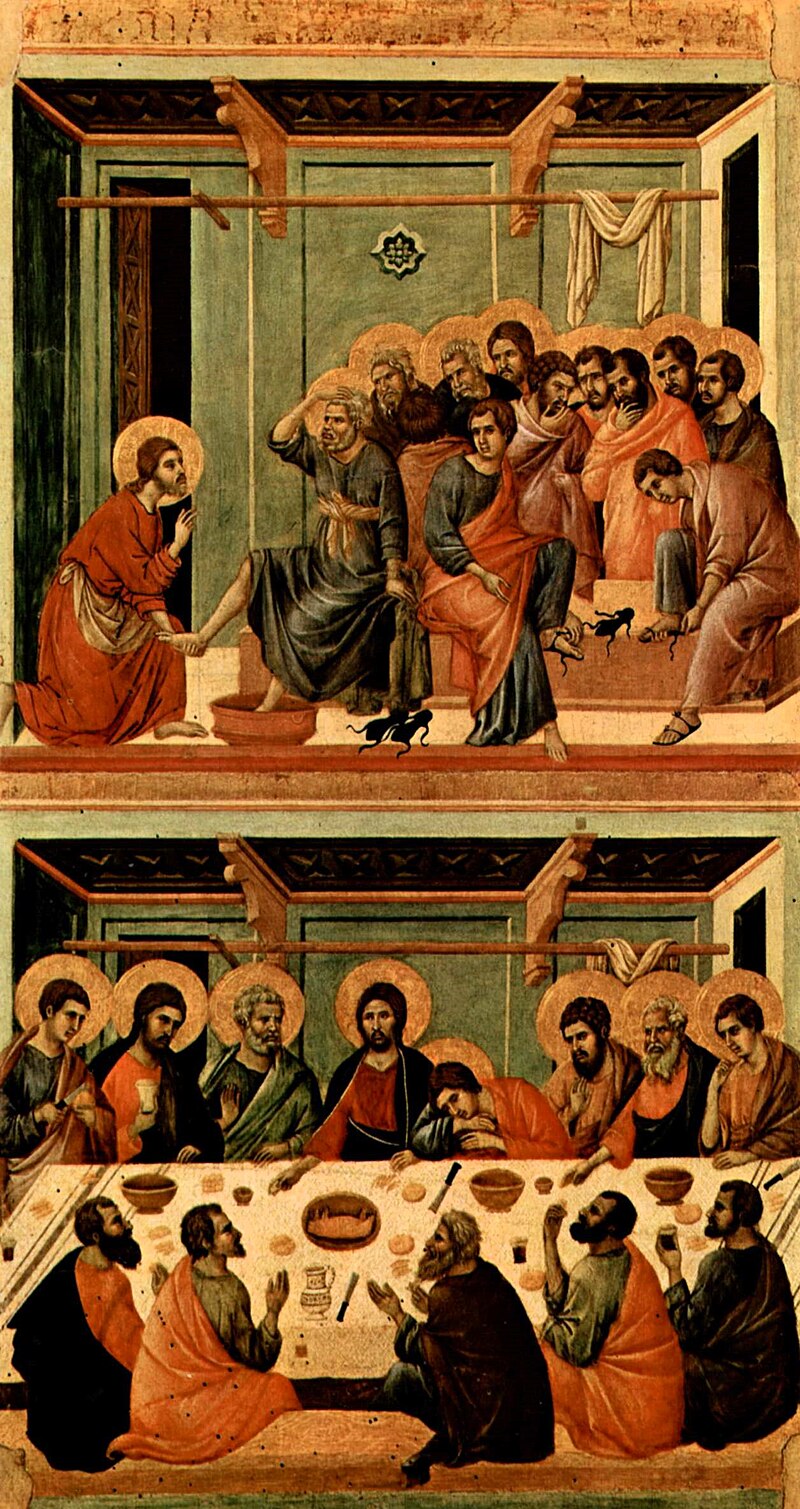 The Washing of Feet and the Supper, from the Maesta by Duccio, 1308–1311. Peter often displays amazement in feet washing depictions, as in John 13:8.[73] St. Thomas Aquinas viewed The Father, Christ, and the Holy Spirit as teachers and masters who provide lessons, at times by example. For Aquinas, the Last Supper and the Cross form the summit of the teaching that wisdom flows from intrinsic grace, rather than external power.[74] For Aquinas, at the Last Supper Christ taught by example, showing the value of humility (as reflected in John's foot washing narrative) and self-sacrifice, rather than by exhibiting external, miraculous powers.[74][75] Aquinas stated that based on John 15:15 (in the Farewell discourse), in which Jesus said: "No longer do I call you servants; ...but I have called you friends,"[76] those who are followers of Christ and partake in the Sacrament of the Eucharist become his friends, as those gathered at the table of the Last Supper.[74][75][77] For Aquinas, at the Last Supper Christ made the promise to be present in the Sacrament of the Eucharist, and to be with those who partake in it, as he was with his disciples at the Last Supper.[78] John Calvin believed only in the two sacraments of Baptism and the "Lord's Supper" (i.e., Eucharist). Thus, his analysis of the Gospel accounts of the Last Supper was an important part of his entire theology.[79][80] Calvin related the Synoptic Gospel accounts of the Last Supper with the Bread of Life Discourse in John 6:35 that states: "I am the bread of life. He who comes to me will never go hungry."[81][80] Calvin also believed that the acts of Jesus at the Last Supper should be followed as an example, stating that just as Jesus gave thanks to the Father before breaking the bread,[82] those who go to the "Lord's Table" to receive the sacrament of the Eucharist must give thanks for the "boundless love of God" and celebrate the sacrament with both joy and thanksgiving.[80] |
最後の晩餐の神学 ドゥッチョ作『マエスタ』より「洗足と晩餐」、1308-1311年。ペトロは、ヨハネによる福音書13:8のように、足を洗う描写においてしばしば驚き を示す[73]。 聖トマス・アクィナスは、父、キリスト、聖霊を、時には模範を示して教訓を与える教師、師とみなした。アクィナスにとって、最後の晩餐と十字架は、知恵は 外的な力ではなく、内在的な恵みから生まれるという教えの頂点を形成している[74]。アクィナスにとって、最後の晩餐においてキリストは、外的な奇跡的 な力を示すのではなく、(ヨハネの足洗いの物語に反映されているように)謙遜と自己犠牲の価値を示し、模範によって教えた[74][75]。 アクィナスは、ヨハネによる福音書第15章15節(別れの講話)に基づき、イエスが次のように述べている: 「もはやわたしはあなたがたをしもべとは呼ばず、......あなたがたを友と呼ぶ」[76]。アクィナスにとって、最後の晩餐においてキリストが弟子た ちとともにおられたように、キリストに従う者であり、聖体の秘跡にあずかる者はキリストの友となるのである[74][75][77]。 ジョン・カルヴァンは洗礼と「主の晩餐」(すなわち聖体)の二つの秘跡のみを信じた。したがって、最後の晩餐に関する福音書の記述を分析することは、彼の 神学全体の重要な部分であった[79][80]。 カルヴァンは、最後の晩餐に関する共観福音書の記述を、ヨハネによる福音書6章35節にある「いのちのパン」の講話と関連づけた: 「わたしはいのちのパンである。わたしのもとに来る者は、決して飢えることがない」[81][80]。 カルヴァンはまた、イエスがパンを裂く前に父に感謝を捧げたように[82]、聖体の秘跡を受けるために「主の食卓」に向かう者は「神の限りない愛」に感謝 を捧げ、喜びと感謝をもって秘跡を祝わなければならない[80]と述べ、最後の晩餐におけるイエスの行為を模範とすべきであると考えていた。 |
| Remembrances Main article: Maundy Thursday See also: Agape feast  Simon Ushakov's icon of the Mystical Supper The institution of the Eucharist at the Last Supper is remembered by Roman Catholics as one of the Luminous Mysteries of the Rosary, the First Station of a so-called New Way of the Cross and by Christians as the "inauguration of the New Covenant", mentioned by the prophet Jeremiah, fulfilled at the last supper when Jesus "took bread, and after blessing it broke it and gave it to them, and said, 'Take; this is my body.' And he took a cup, and when he had given thanks he gave it to them, and they all drank of it. And he said to them, 'This is my blood of the covenant, which is poured out for many.'"[83] Other Christian groups consider the Bread and Wine remembrance to be a change to the Passover ceremony, as Jesus Christ has become "our Passover, sacrificed for us",[84] and hold that partaking of the Passover Communion (or fellowship) is now the sign of the New Covenant, when properly understood by the practicing believer. These meals evolved into more formal worship services and became codified as the Mass in the Catholic Church, and as the Divine Liturgy in the Eastern Orthodox Church; at these liturgies, Catholics and Eastern Orthodox celebrate the Sacrament of the Eucharist. The name "Eucharist" is from the Greek word εὐχαριστία (eucharistia) which means "thanksgiving". Early Christianity observed a ritual meal known as the "agape feast"[a] These "love feasts" were apparently a full meal, with each participant bringing food, and with the meal eaten in a common room. They were held on Sundays, which became known as the Lord's Day, to recall the resurrection, the appearance of Christ to the disciples on the road to Emmaus, the appearance to Thomas and the Pentecost which all took place on Sundays after the Passion. |
追悼 主な記事 聖木曜日 も参照してください: アガペーの祝日  シモン・ウシャコフの神秘の晩餐のイコン 最後の晩餐における聖体の制定は、ローマ・カトリックではロザリオの光明神秘のひとつ、いわゆる新しい十字架の道の第一駅として、またキリスト教では預言 者エレミヤが言及した「新しい契約の開始」として記憶されている。そして、杯を取り、感謝をささげてから彼らにお渡しになった。そして彼らに言われた、 『これは多くの人のために注がれる、わたしの契約の血である』」[83]。他のキリスト教グループは、イエス・キリストが「わたしたちのために犠牲となっ た、わたしたちの過越の祭り」となられたので、パンとぶどう酒を思い起こすことは過越の儀式への変更であると考え[84]、過越の聖餐(または交わり)に あずかることは、実践している信者が正しく理解するならば、今や新約のしるしであるとする。 これらの食事は、より正式な礼拝へと発展し、カトリック教会ではミサとして、東方正教会では神聖典礼として成文化された。聖体」という名前は、ギリシャ語 で「感謝」を意味するεŐχαριστία (eucharistia)に由来する。 初期キリスト教では、「アガペーの祝宴」[a]として知られる儀式的な食事が行われていた。この「愛の祝宴」は、参加者がそれぞれ食べ物を持ち寄り、共通 の部屋で食事をする、完全な食事であったようだ。復活、エマオへの道で弟子たちにキリストが現れたこと、トマスに現れたこと、そして聖霊降臨がすべて受難 後の日曜日に行われたことを思い起こすために、主日として知られるようになった日曜日に行われた。 |
Passover parallels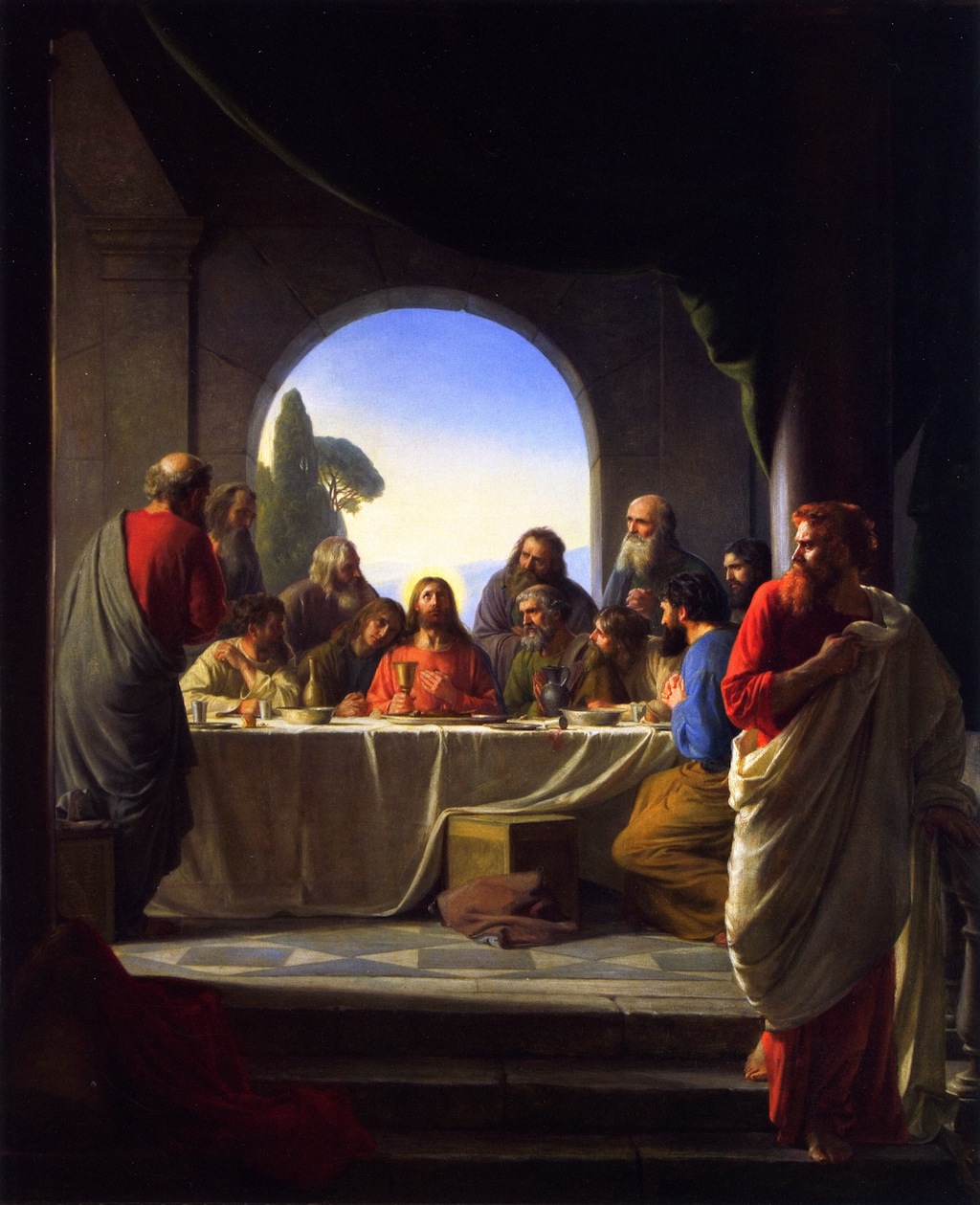 Last Supper, Carl Bloch. In some depictions John the Apostle is placed on the right side of Jesus, some to the left. Since the late 20th century, with growing consciousness of the Jewish character of the early church and the improvement of Jewish-Christian relations, it became common among some evangelical groups to borrow Seder customs, like Haggadahs, and incorporated them in new rituals meant to mimic the Last Supper.[citation needed] As the earliest elements in the current Passover Seder (a fortiori the full-fledged ritual, which is first recorded in full only in the ninth century) are a rabbinic enactment instituted in remembrance of the Temple, which was still standing during the Last Supper,[85] the Seder in Jesus' time would have been celebrated quite differently, however. In Islam The fifth chapter in the Quran, Al-Ma'ida (the table) contains a reference to a meal (Sura 5:114) with a table sent down from God to ʿĪsá (i.e., Jesus) and the apostles (Hawariyyin). However, there is nothing in Sura 5:114 to indicate that Jesus was celebrating that meal regarding his impending death, especially as the Quran states that Jesus was never crucified to begin with. Thus, although Sura 5:114 refers to "a meal", there is no indication that it is the Last Supper.[86] However, some scholars believe that Jesus' manner of speech during which the table was sent down suggests that it was an affirmation of the apostles' resolves and to strengthen their faiths as the impending trial was about to befall them.[87] Historicity  The Last Supper by Michael Damaskinos circa 1591 According to John P. Meier and E. P. Sanders, Jesus having a final meal with his disciples is almost beyond dispute among scholars, and belongs to the framework of the narrative of Jesus' life.[88][89] I. Howard Marshall states that any doubt about the historicity of the Last Supper should be abandoned.[14] Some Jesus Seminar scholars consider the Last Supper to have derived not from Jesus' last supper with the disciples but rather from the gentile tradition of memorial dinners for the dead.[90] In their view, the Last Supper is a tradition associated mainly with the gentile churches that Paul established, rather than with the earlier, Jewish congregations.[90] Such views echo that of 20th century Protestant theologian Rudolf Bultmann, who also believed the Eucharist to have originated in Gentile Christianity.[19][20] On the other hand, an increasing number of scholars have reasserted the historicity of the institution of the Eucharist, reinterpreting it from a Jewish eschatological point of view: according to Lutheran theologian Joachim Jeremias, for example, the Last Supper should be seen as a climax of a series of Messianic meals held by Jesus in anticipation of a new Exodus.[91] Similar views are echoed in more recent works by Catholic biblical scholars such as John P. Meier and Brant Pitre, and by Anglican scholar N.T. Wright.[92][17][93] |
過越の祭りの類似点 最後の晩餐、カール・ブロッホ 使徒ヨハネがイエスの右側に描かれたものもあれば、左側に描かれたものもある。 20世紀後半以降、初代教会のユダヤ教的性格に対する意識が高まり、ユダヤ教徒とキリスト教徒の関係が改善されるにつれて、一部の福音主義グループの間で は、ハガダーのようなセーデルの習慣を借用し、最後の晩餐を模倣することを意図した新しい儀式に取り入れることが一般的になった。 [しかし、現在の過越のセダー(本格的な儀式は9世紀になって初めて完全な形で記録されている)の最も初期の要素は、最後の晩餐の間にまだ建っていた神殿 を思い起こすために制定されたラビ制定法であるため[85]、イエスの時代のセダーはまったく異なる形で祝われていたであろう。 イスラム教では コーランの第5章、アル・マーイダ(食卓)には、神から/Īsá(すなわちイエス)と使徒たち(ハワーリイイン)に下された食卓を用いた食事(スラ5: 114)への言及がある。しかし、クルアーン5:114には、イエスが差し迫った死に関してその食事を祝っていたことを示すものは何もない。このように、 スーラ5:114は「食事」に言及しているが、それが最後の晩餐であることを示すものはない。[86]しかし、食卓が下された時のイエスの話し方は、使徒 たちの決意を確認し、差し迫った試練が彼らに降りかかろうとしていた彼らの信仰を強めるためのものであったことを示唆していると考える学者もいる [87]。 歴史性  1591年頃、ミヒャエル・ダマスキノスによる「最後の晩餐」 ジョン・P・マイヤーとE・P・サンダースによれば、イエスが弟子たちと最後の食事をしたことは学者たちの間でほとんど議論の余地がなく、イエスの生涯の 物語の枠組みに属するものである[88][89]。 I・ハワード・マーシャルは、最後の晩餐の歴史性についての疑念は捨て去るべきだと述べている[14]。 ジーザス・セミナーの研究者の中には、最後の晩餐はイエスの弟子たちとの最後の晩餐に由来するのではなく、むしろ死者のための追悼の晩餐の異邦人の伝統に 由来すると考える者もいる[90]。彼らの見解では、最後の晩餐はそれ以前のユダヤ人の信徒たちよりも、むしろパウロが設立した異邦人の教会に主に関連す る伝統である[90]。このような見解は、20世紀のプロテスタントの神学者ルドルフ・ブルートマンの見解と同じであり、彼もまた聖体は異邦人のキリスト 教に由来すると考えていた[19][20]。 その一方で、ユダヤ教の終末論的観点から聖体を再解釈し、聖体創建の歴史性を主張する学者も増えている。例えば、ルター派の神学者ヨアヒム・イェレミアス によれば、最後の晩餐は、新たな出エジプトを予期してイエスが行った一連のメシア的食事のクライマックスと見なされるべきであるという。 [同様の見解は、ジョン・P・マイヤーやブラント・ピートルといったカトリックの聖書学者や、聖公会の学者であるN.T.ライトによる最近の著作でも繰り 返されている[92][17][93]。 |
| Artistic depictions Main article: Last Supper in Christian art The Last Supper has been a popular subject in Christian art.[1] Such depictions date back to early Christianity and can be seen in the Catacombs of Rome. Byzantine artists frequently focused on the Apostles receiving Communion, rather than the reclining figures having a meal. By the Renaissance, the Last Supper was a favorite topic in Italian art.[94] There are three major themes in the depictions of the Last Supper: the first is the dramatic and dynamic depiction of Jesus's announcement of his betrayal. The second is the moment of the institution of the tradition of the Eucharist. The depictions here are generally solemn and mystical. The third major theme is the farewell of Jesus to his disciples, in which Judas Iscariot is no longer present, having left the supper. The depictions here are generally melancholy, as Jesus prepares his disciples for his departure.[1] There are also other, less frequently depicted scenes, such as the washing of the feet of the disciples.[95] The best known depiction of the Last Supper is Leonardo da Vinci's The Last Supper, which is considered the first work of High Renaissance art, due to its high level of harmony.[96] Among other representations, Tintoretto's depiction is unusual in that it includes secondary characters carrying or taking the dishes from the table,[97] and Salvador Dali's depiction combines the typical Christian themes with modern approaches of Surrealism.[98] https://en.wikipedia.org/wiki/Last_Supper |
芸術的描写 主な記事 キリスト教美術における最後の晩餐 最後の晩餐は、キリスト教美術において人気のある題材である[1]。このような描写は初期キリスト教にさかのぼり、ローマのカタコンベで見ることができ る。ビザンチン時代の画家たちは、横になって食事をしている人物よりも、むしろ聖体拝領を受けている使徒たちに焦点を当てることが多かった。ルネサンス期 には、「最後の晩餐」はイタリア美術で好まれるテーマとなった[94]。 最後の晩餐の描写には3つの主要なテーマがある。1つ目は、イエスの裏切りの告知の劇的でダイナミックな描写。第二は、聖体の伝統が制定される瞬間であ る。ここでの描写は概して厳粛で神秘的である。第三の主要テーマは、弟子たちに対するイエスの別れの場面であり、そこではイスカリオテのユダは晩餐の場を 去り、もはやその場にいない。ここでの描写は、イエスが弟子たちに旅立ちの準備をさせるため、概して憂鬱なものである[1]。また、弟子たちの足を洗う場 面など、あまり頻繁に描かれない場面もある[95]。 最後の晩餐の描写で最もよく知られているのはレオナルド・ダ・ヴィンチの『最後の晩餐』であり、その調和性の高さから、ハイ・ルネサンス美術の最初の作品 とされている[96]。 他の表現では、ティントレットの描写は、テーブルから食器を運んだり取ったりする副次的な人物を含むという点で異例であり[97]、サルバドール・ダリの 描写は、典型的なキリスト教のテーマとシュルレアリスムの現代的なアプローチを組み合わせたものである[98]。 |
Stanley Spencer
1891-1959, "The last supper" 1920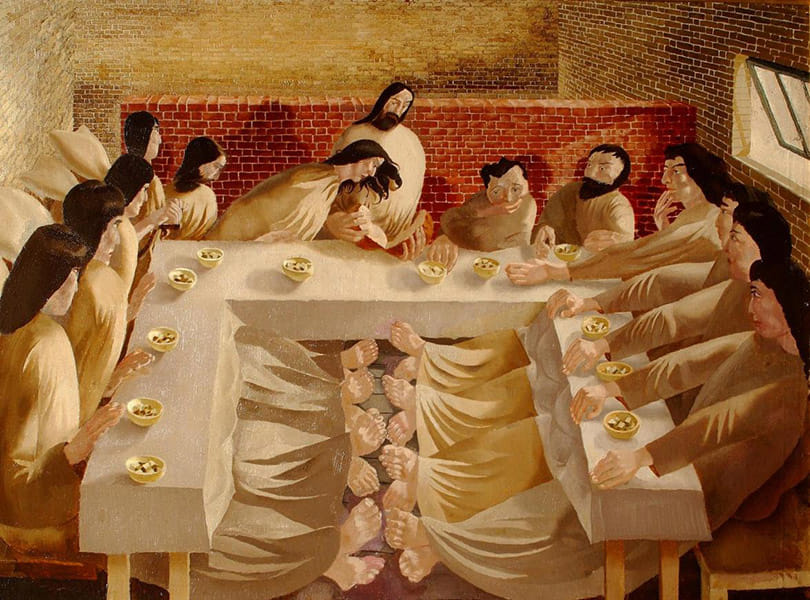 |
スタンリー・スペンサー「最後の晩餐」(1920) |
★愛餐(あいさん:agapē)とは、キリスト教会で信徒が共にする食事や、その食事にまつ わる意味を指す
紀元3世紀のローマのカタコンペに描かれたフレスコ
★ルーカス・クラナッハ(父)の最後の晩餐、ちゃっかり、マルチン・ルターも参加している
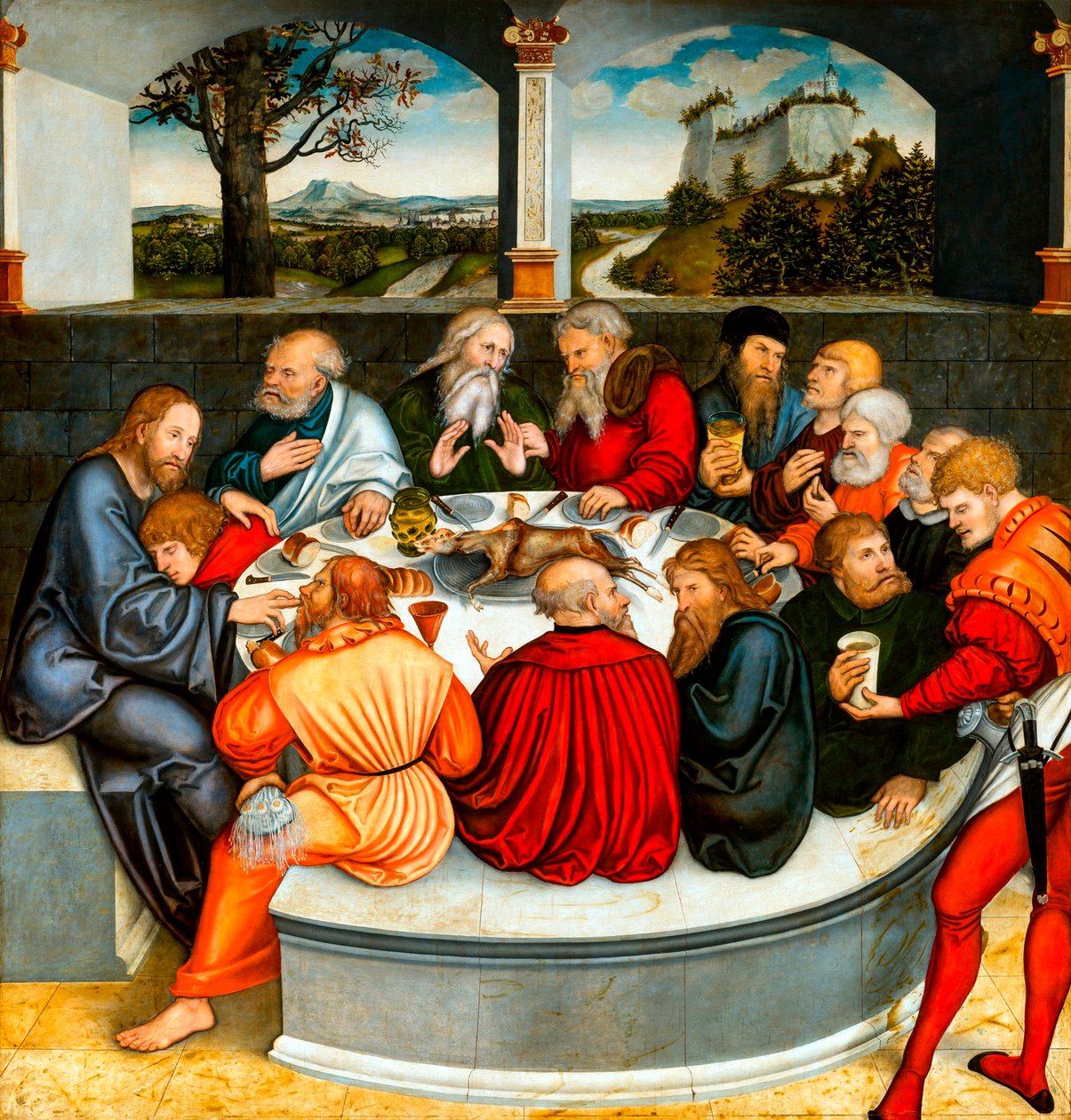
Links
Bibliography
Other informations
このページのオリジナル情報は、ダイキン工業株式会社による「基礎検討フェーズ報告書・研究 テーマ提案」から「2020年度共同研究委受託研究」のフィージビリティ調査研究費より支援を受けて作成されました。関係者に深謝します。
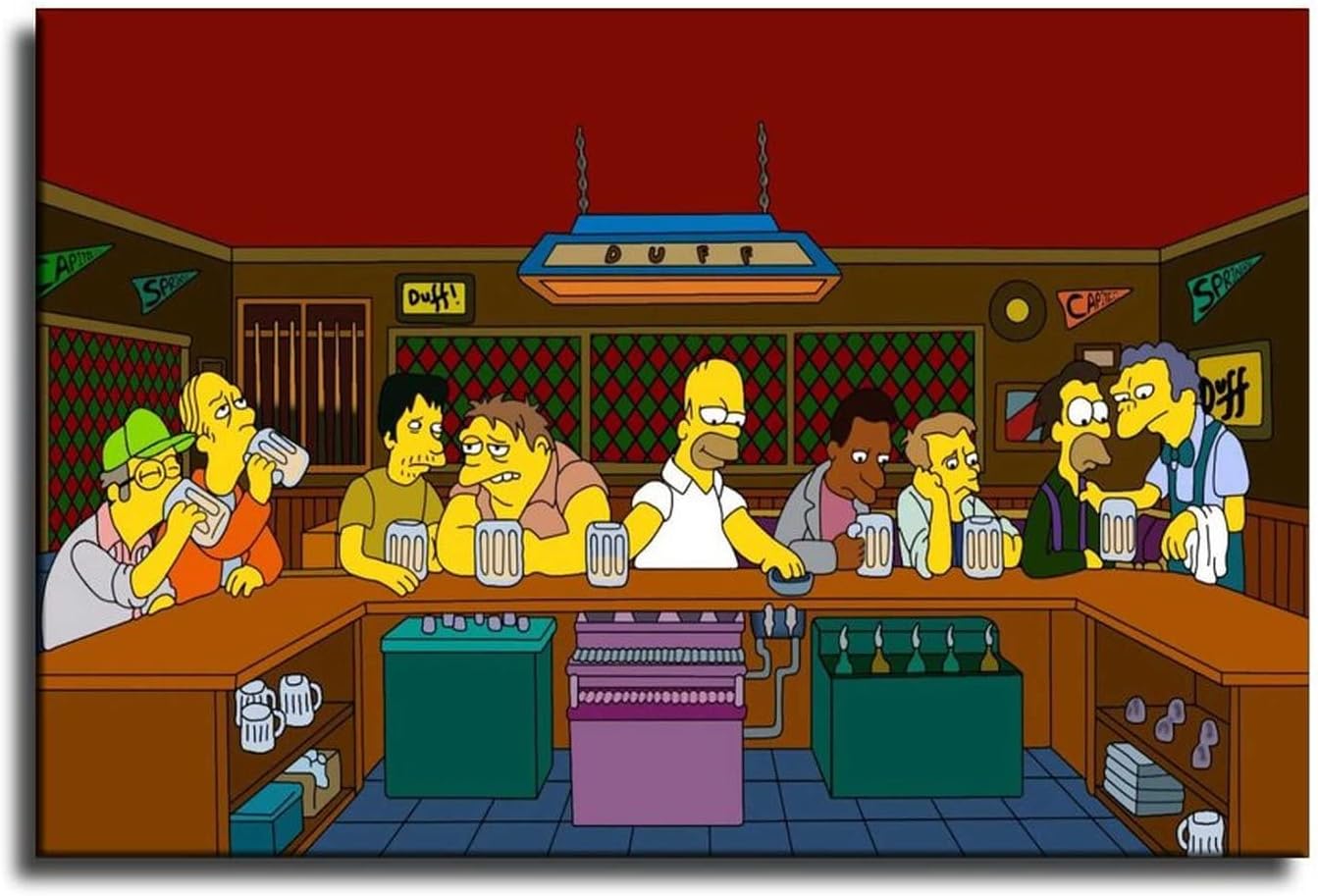
Copyleft, CC, Mitzub'ixi Quq Chi'j, 1996-2099
☆
 ☆
☆